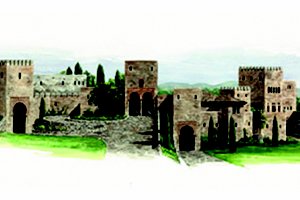Even with a decade of regulatory delays and the massive size of
the project, the American Institute of Mathematics’ new Morgan Hill
headquarters will probably be built more quickly than was the
medieval Spanish castle the facility is modeled after.
Even with a decade of regulatory delays and the massive size of the project, the American Institute of Mathematics’ new Morgan Hill headquarters will probably be built more quickly than was the medieval Spanish castle the facility is modeled after.
Developers finally gained approval to begin construction on the four-story replica of the 14th-century Alhambra castle that will tower above southeast Morgan Hill as the think tank’s new headquarters. The facility will attract mathematicians from all over the world, and eventually host the Frys.com Open PGA Tour event, according to the developers.
Grading is underway at the site near the corner of Maple and Foothill avenues east of U.S. 101, according to Manuel Valerio, spokesman for property owner, electronics magnate and AIM co-founder John Fry.
“Fry’s (electronics stores) and AIM are certainly pleased that this phase of the project is underway again and we look forward to continued progress in future stages of the project,” Valerio said.
The permitted earth-moving began earlier this year, and follows a standoff between the city and AIM over the geologic stability of the construction site which began in 2009. That holdup, resolved late last year, followed a decade of setbacks of the 192-acre site owned by Fry, which includes the 18-hole Institute golf course.
Developers don’t have an expected date of completion for the facility, Valerio said, though there’s no indication it will take as long as it took to build the medieval Spanish Alhambra, which was constructed over the better part of the 14th century.
“Right now all the work crews are doing is continuing the work that was halted (before) the seismic study was approved,” Valerio said. “The next step will be the foundation.”
When completed, the AIM castle will span more than 170,000 square feet with 21 hotel-style rooms for lodging, 20 offices, a lecture hall, theater and other amenities. More than 25 workshops, 30 “squares” or brainstorming sessions attended by mathematicians and researchers, plus a number of special events and conferences will be hosted at the AIM facility, and will bring hundreds of the world’s top math and science professionals to Morgan Hill every year, AIM executive director Brian Conrey said. About 10 full-time AIM staff people will work out of the castle.
Developers think the new headquarters, to be relocated from the current Palo Alto office building AIM is housed in, will be an educational, economic and aesthetic asset to the community.
“It will bring world-class mathematicians to Morgan Hill to work on some of the outstanding math problems, and it will be a place where students and people interested can focus on enrichment,” said Conrey, who lives in San Martin.
Plus, Frys.com has long lobbied to bring the PGA Tour event it sponsors to the Institute course. The AIM castle will incorporate a clubhouse, locker rooms and pro shop for golfers, making the tour’s long-term move to the course more feasible, Valerio said.
“In the future, if there were a PGA event there, we believe it would bring a great deal of economic benefit to the community,” Valerio said. “Subsequent to that, the PGA donates a lot of money to local charitable causes” which will be an asset to all of South Santa Clara County.
The property is adjacent to a square-mile former landslide – the center of the latest holdup on the AIM center’s construction. State laws require geologic studies of certain sites – the AIM development being one of them – to ensure construction won’t destabilize the earth, stirring up potential unintended earth movement.
AIM’s geologist thought the developer’s initial study of the site, which found the property to be stable enough for construction, was adequate. However, the city’s geologist and an independent consultant conducting a peer review thought deeper digging and more information was needed to satisfy state requirements.
AIM developers initially refused to conduct further studies, which would have cost tens of thousands of dollars more. The impasse resulted in a three-hour debate among city council members in January 2009, when the body voted 3-2 to subsidize a portion of the developer’s costs for the seismic study.
Since then, the city contracted with Santa Clara County geologist Jim Baker, and after a back-and-forth negotiation AIM agreed to conduct further studies, city attorney Danny Wan said. The more-in-depth studies, which consisted of earth borings, water level testing and other tests, found the site is safe and will not require any mitigation or improvement measures.
“The county geologist signed off and said we have enough information to be assured this is a zone of reasonable safety,” Wan said. “And that’s what the city was after from the beginning, was more information so we could make that determination.”












